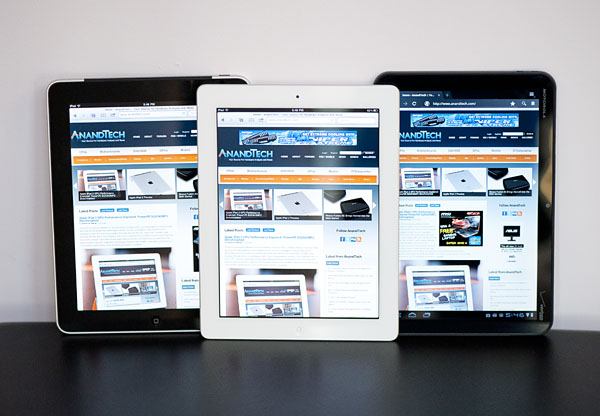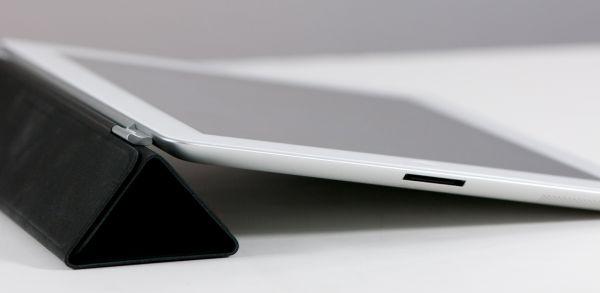Tablets: How Would You Solve the Input Problem?
by Anand Lal Shimpi on March 29, 2011 2:22 PM EST- Posted in
- Tablets
- Apple
- iPad 2
- Ask AnandTech
- Mobile
In our iPad 2 review I mentioned that despite really liking the device, I never really could integrate the original iPad into my daily life in a meaningful way. I always ended up traveling with the iPad and a notebook or while around town I just kept a smartphone on me. That limited my iPad use to pretty much lounging around at the house, and even then I found myself turning to the laptop more often than not.
With the Xoom and iPad 2 I've been giving the tablet usage model another try. I've kept my usage mostly consumption focused. Browsing the web and reading emails. I really do prefer using a tablet for both of these things. I do wish the iPad 2 was faster when selecting lots of emails but the improvement over the original iPad is still considerable.
My holdup is this: while I love reading on the iPad 2, I have troubles contributing using it. Writing lengthy email responses or even posting comments on AT is just slower on the iPad than on a notebook. The solution can't be to just walk over to a laptop when I want to respond and just use the iPad when I'm reading - that seems horrible inefficient.
I could use a Bluetooth keyboard but that's also rather clunky. I feel like there has to be a better solution going forward, particularly as the tablet market grows. Is it voice? Or some sort of an integrated kickstand with more flexibility than what you get with the smart cover?
I feel like smartphones get a pass because it's easy to type on them regardless of where you're sitting. Tablets on the other hand need to be propped up against something and as a result are harder to type on in certain situations. They work fine on a desk but if I'm at a desk I'd rather use a notebook. What about when laying back on a couch?
I'm curious what you all think about this. Am I alone in finding tablet ergonomics a barrier? If not, what do you believe is the best solution for tablets going forward. I want to read and respond on a tablet as quickly as I can on a notebook. What needs to be built? Post your comments here and I'm sure we can get many of the tablet manufacturers to pay attention. I don't think they have stumbled across the best solution for this problem either, so what you say here might go a long way in making tablets better for everyone.












247 Comments
View All Comments
Qmzn - Wednesday, March 30, 2011 - link
i was sitting at a play once, and during intermission, a 16-year-old teen was typing on his iPhone as fast, or faster, than I touch type. So I think typing on a tablet or phone is a skill traditional typists are hesitant to develop, when touch-typing already works so well for them.So I try and force myself to get better at using a keyboard without tactile response. I do think the key spacing is too tight on iPad portrait layout, though--too wide for thumbs, too tight for two hands. If I want any chance of speed, I have to rotate to landscape.
I think the next upgrade should be haptic technology, but I worry about it being engineered responsibly. I don't want a device that can be turned into a ultrasound Chinese finger trap with the right virus. Adding keyboards or extra buttons to tablets just feels like it's chipping away at the pure simplicity of the device.
Right now, I think the best help would be reworking auto-correct to be less obtrusive, with learning functionality and grammar recognition.
titerito - Wednesday, March 30, 2011 - link
how about a small bluetooth keyboard about the size of a cellphone keyboard....it could be nice that the keyboard could be integrated into a small port of the Ipad and then take it out when needed!! just like a HP power point controller that fits into the notebook and then taken out when needed. It would be just like texting on a Ipad ;)Adelphos - Wednesday, March 30, 2011 - link
You say you are focusing on keeping your usage of the iPad and Xoom "consumption" oriented, mainly "browsing the web and reading emails." The issue is that you are missing the most important aspect of the tablet experience - using apps. E-mail and web browsing continue to be optimized for keyboard and mouse/touchpad usage. They are very good on tablets, but they aren't optimized for tablets.However, tablet apps are customized for the touchscreen input method. This can be useful for both consumption and "work." For example, the Wall Street Journal, Netflix, Pandora apps are excellent for consumpion on the iPad. However, I have several finance apps on my iPad. When I want to bring up a stock to analyze, the apps tend to bring up a text entry field with a suggestion box under it. After typing in a few characters, the intended stock tends to appear below. Then, I am taken to a new screen where tablet optimized gestures let me gather useful information. Obviously, developers can come up with unlimited scenarios to tailor work to the tablet experience.
Most of the writers and readers on this site are going to be doing work that involves text and data entry, manupulation of images, etc. This simply cannot be done efficiently on a tablet. If you want your computing world to be streamlined (i.e. using the fewest amount of devices) a tablet is simply not going to be for you. I don't see a reason to fight this realization.
When Jobs and others are talking about a "post-PC era," they recognize that most computer users today are simply casual users. Throughout the 1990s, all industry players marketed the idea that every person in a household needed a powerful computer. Everyone, including Microsoft, Intel, Apple, Dell, Gateway, HP, AOL, whoever was invested in this idea. In addition, they marketed the idea that the average family needed a new, powerful computer every year. This is simply not the case. For example, a household (2 parents, 3 kids) may get by with just one basic desktop computer and 4 our 5 ipads. The desktop will be relagated for use on completing the family budget or for Johnny to write his term paper. But all other "computing" will be easily done on $500 iPads. Dad will read the WSJ and maybe do the family taxes on turbotax. Mom will find a new recipe on epicurious on her iPad. Johnny will play Infinity Blade and watch MLB at Bat on his iPad. Sally will tweet and facebook on her iPad. etc. Keep a spare bluetooth keyboard around just in case both Sally and Johnny need to write paperrs.
albiglan - Wednesday, March 30, 2011 - link
Truth is that these devices are used in too many different ways so support a single input mechanism.1) A graffiti style handwriting system would be nice to incorporate (1996 US Robotics FTW!)
2) Support for BT keyboards/cases would be very nice for typing long long papers/articles/etc.
3) Thumb centric on screen keyboard for typing while reading on the train/bus holding with two hands
4) Regular old "bottom 30%" keyboard as well
5) Speech recog - tho I question this is really all that helpful except in a very limited set of users., but hey, it's just an App! :-)
I'd like to see 1) and 3) become more "standard by default" as part of the device OS. I'll pick 2) and 5) from a 3rd party thanks, and 4) is already there...
I disagree that one of the issues is -not- tactile response. Being able to "sense where you are" on a keyboard helps a great deal. cool R&D concept would be a "raised grid" on the touch screen that is available in keyboard mode, but anytime else. Some kind of piezoelectric grid that gives the slightest of raised edges for key boundaries. For more win, make the whole key "depress" slightly then rebound when used.
I'm probably the only one who still likes the graffiti system, eh?
-al
mrshmir - Wednesday, March 30, 2011 - link
Has this issue been solved on Star Trek? Or are the applications they use extremely simple to use that they only need to hit 1 or 2 buttons. Perhaps drop down menus and radio buttons should be used more often than typing on a keypad.wollyka - Wednesday, March 30, 2011 - link
A pen or/and improve handwriting recognition with one finger. So you can wrote whole phrases just like you do on a real notepad.Wave Fusion - Wednesday, March 30, 2011 - link
I'm not convinced Tablets with ever evolve. They will get faster, some might key keyboards, some won't, like 3D its just the newest new thingEven if they become the center device and everything else just connects or syncs to it, directly or via the cloud, it won't matter, because if tablets can do it so could anything else.
I see tablets as mostly just a CORDLESS DISPLAY
Think about it.. its too bulky to use as a phone, and not equipped heavily enough to replace PCs and makes for a poor input device.
Other than being convenient to view media, (pretty much textbook definition of a display) they don't really do anything 'better'.
Mishera - Wednesday, March 30, 2011 - link
I like the idea of pen or voice recognition, but I think the technology simply hasn't been developed enough for them to be really useful. But I think I found you answer:Put the dock on the horizontal end just add a keyboard. Really simple. In our cs lab we have a bunch umpcs that look exactly like that running windows. Seriously are we going backwards? It seems that we solved this issue several ways a long time ago. But guess what? Apple won't do it!! That would quickly cut into sales of their laptops. The keyboard dock they sell is a joke, and if it were any other company they wouldn't get away with it.
Having said that I really don't have too many problems with the ergonomics. Honestly I see tablets in right now being information hubs, always connected to severs for accomplishing tasks. That would eliminate you power issue if Apple provided a better ecosystem. Other than that they're pretty much consumption devices. I read a lot and the iPad pretty much covers all my news, and earnings reports (the kindle's screen is too small for those). But it rarely leaves the house so having something smaller like a galaxy tab with a add-on keyboard would be nice, but so many companies are caught up with catching Apple that it probably won't happen...
ShortyZ - Wednesday, March 30, 2011 - link
Integrate smartphone/tablet technology into a notebook? What notebooks basically lack now are built in telephones. Some spare keyboard area could be used for a touch screen, apps and all. I know people that use their phones to wifi their notebooks, what a waste.Beijingabc - Wednesday, March 30, 2011 - link
Well if voice recognition is no good, why not investigate lip reading?1. Activate Camera
2. You mouth what you want to say
3. Computer interprets it and types it out.
Possible?
Maybe. People can do it.